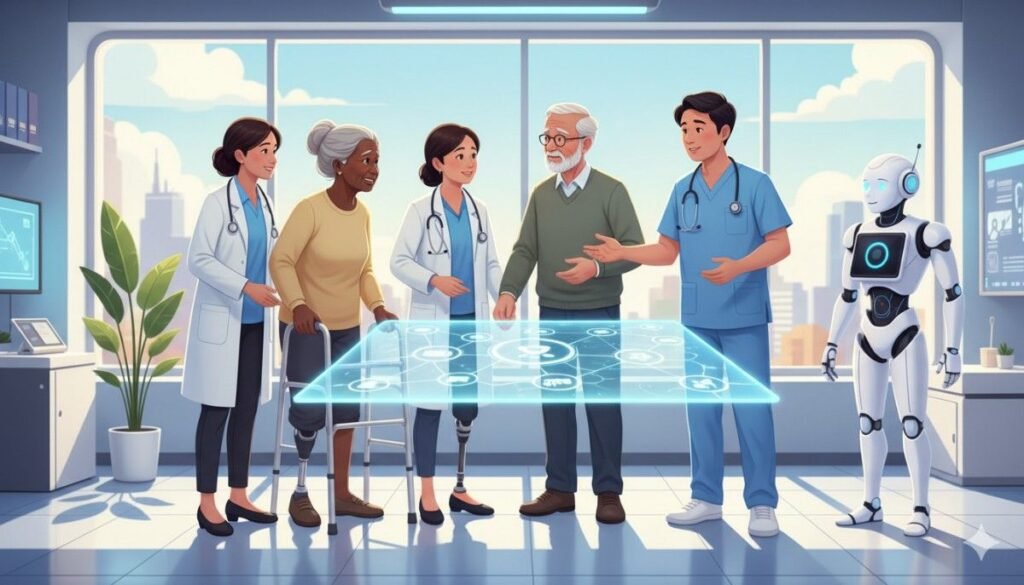Growing older brings wisdom, memories, and stories — but it also brings physical challenges that can quietly change how a person lives. For many older adults, mobility becomes the measure of independence. A simple fall, a chronic condition, or an amputation can suddenly make everyday tasks seem impossible.
For physicians, this is where guidance matters most. The way doctors approach prosthetic care in elderly patients can decide whether they stay active or become confined to a chair. Early fitting, fall prevention, and frailty management aren’t just clinical steps — they are lifelines to confidence, dignity, and continued participation in life.
Unlike younger amputees, geriatric candidates face a delicate balance between physical limitation and emotional resilience. Their bodies may be slower to heal, but their desire to stay independent remains strong. The physician’s role, therefore, goes beyond prescribing devices. It’s about timing, encouragement, and ensuring that the prosthesis adds to life rather than burdening it.
In this article, we’ll explore how doctors can make these decisions with care — understanding when to fit early, how to reduce falls, and how to manage frailty so that aging patients can continue to live freely.
Because even in the golden years, every step taken with confidence is a victory worth protecting.
Understanding Geriatric Amputation and Rehabilitation
The Complexities of Aging and Mobility
Aging changes everything about how the body moves. Muscles weaken, reflexes slow, and balance becomes more fragile. When a senior loses a limb, whether from diabetes, vascular disease, or trauma, it’s not just a physical change — it’s an emotional one too.
Mobility is often tied to self-worth. Losing it can bring anxiety, fear, and frustration. Many elderly patients begin to withdraw, worried they might fall or depend too much on others. For doctors, helping them regain that confidence is just as vital as helping them walk again.
The Emotional Landscape of Older Patients
Older adults who undergo amputation experience a range of emotions — shock, denial, grief, and, at times, guilt. Some fear becoming a burden to their families, while others lose motivation to pursue rehabilitation.
Physicians and caregivers must recognize these emotions early. When emotional support accompanies medical care, recovery feels less like a clinical process and more like a journey back to dignity. Gentle reassurance and setting small, achievable goals help patients rediscover belief in themselves.
A simple sentence like “You’ll walk again” can have a deeper effect than any prescription.
The Difference Between Young and Elderly Amputees
Unlike younger patients, elderly individuals face unique limitations — slower healing, reduced stamina, and sometimes existing medical conditions like heart disease or arthritis. These factors can make recovery unpredictable.
But there’s also an advantage: older patients often show higher compliance and patience during rehabilitation. They follow routines, value medical guidance, and focus on progress rather than perfection. With proper encouragement and realistic goals, their recovery can be steady and meaningful.
How Loss of Mobility Affects the Mind
When movement stops, the mind suffers. Seniors confined to beds or chairs often face depression and cognitive decline. The lack of physical activity slows circulation, weakens bones, and affects sleep and appetite.
This creates a cycle — reduced movement leads to frailty, which increases the risk of falls and injuries, making mobility even harder. Physicians who prioritize prosthetic rehabilitation early can break this cycle before it starts.
Movement heals not just muscles, but the mind.
The Importance of Early Prosthetic Fitting in Geriatric Care
Why Early Fitting Matters
After amputation, many elderly patients are advised to rest for long periods before considering prosthetic fitting. While rest is essential, waiting too long can make adaptation harder. Muscles weaken, joints stiffen, and balance deteriorates rapidly.
Early prosthetic fitting — once the wound is healed and pain is controlled — allows the patient to re-engage with daily life before fear or hesitation set in. The sooner they start moving, the better their coordination and confidence become.
For physicians, recommending timely fitting isn’t just a clinical choice. It’s an act of preserving independence.
Restoring Balance and Preventing Deconditioning
The human body adapts quickly, even in old age. If a senior spends months relying on one limb, the body begins to favor that side. This imbalance can cause back pain, uneven posture, and a higher risk of falls.
By introducing a prosthesis early, doctors help the patient regain symmetry. Early walking practice, even with limited support, strengthens core muscles and improves cardiovascular health. It also prevents long-term dependence on walking aids.
Every small step taken early shortens the road to recovery.
Reducing Psychological Barriers
Fear of falling is one of the biggest mental obstacles for elderly amputees. Even if physically ready, many hesitate to walk again because they’ve lost trust in their balance.
Early prosthetic rehabilitation helps counter that fear. When guided gently by therapists, patients learn safe standing, controlled stepping, and how to manage uneven surfaces. This training restores both confidence and courage.
Doctors should remind patients that prosthetics today are stable, light, and designed for comfort — far from the heavy, awkward devices of decades past. Modern prosthetic hands and legs, like those developed by RoboBionics, are created with ease of use in mind, encouraging natural motion even for fragile users.
The Timing Balance: Not Too Early, Not Too Late
Timing matters. If fitted too early, before the wound fully heals, pain and irritation can discourage use. If delayed too long, the body forgets its natural gait.
The ideal moment is when the residual limb has healed, swelling has subsided, and the patient can sit and stand with some balance. Doctors and prosthetists must coordinate closely to find this sweet spot — typically between 6 to 10 weeks after surgery, though it varies by case.
This collaboration ensures a safe, confident start to prosthetic use.
Early Fitting and the Prevention of Frailty
Frailty — the gradual weakening of muscles, bones, and stamina — is a common enemy of aging. It reduces resilience and makes even small falls dangerous.
Early prosthetic fitting directly combats frailty. Walking reactivates circulation, strengthens heart and lung function, and maintains bone density. It also boosts mood and encourages social interaction.
For elderly patients, these benefits are more than physical. They represent the difference between passive existence and active living.
The Physician’s Role in Restoring Mobility
Seeing Beyond the Surgery
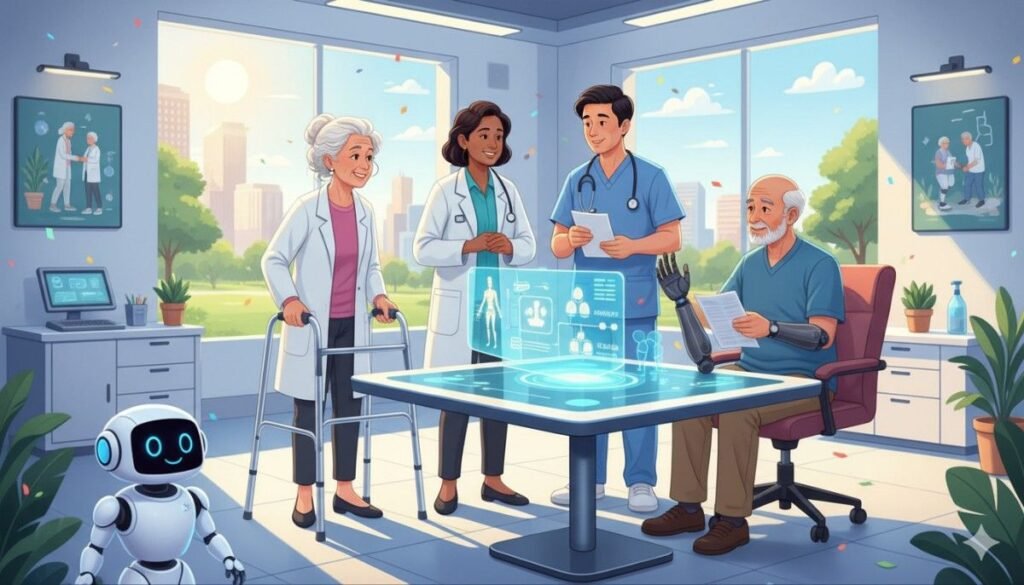
Many physicians focus primarily on surgical healing after amputation — ensuring the wound closes, pain subsides, and infection is prevented. But real recovery starts only after that phase.
Physicians who think beyond the surgery — who plan for mobility from day one — give their patients a head start. Introducing the idea of prosthetics early, even during pre-surgery counseling, helps patients visualize a future beyond loss.
This mental preparation can make rehabilitation smoother and faster once the prosthesis is ready.
Communication and Patient Readiness
Older adults value trust above all else. They are more likely to accept new interventions when their doctor explains them clearly and patiently.
When discussing prosthetic fitting, simple words work best. Avoiding technical jargon and focusing on benefits — comfort, balance, confidence — helps build understanding. Showing a picture or demo of a modern prosthetic can replace fear with curiosity.
Physicians should also involve family members in the discussion. Their support will be crucial in ensuring consistent use and follow-up.
Identifying the Right Candidates
Not every elderly patient will adapt to prosthetics in the same way. Some have good upper body strength and motivation; others may have cognitive decline or multiple medical issues.
Physicians must assess each individual carefully — considering endurance, cardiac health, joint flexibility, and emotional readiness. The goal is not to push every patient toward prosthetic use, but to ensure those who can benefit, do so without hesitation.
Even partial prosthetic use — like a temporary training device — can improve balance and reduce falls for many seniors.
Team-Based Care for Best Outcomes
Successful geriatric rehabilitation depends on teamwork. The physician is the anchor, but the prosthetist, physiotherapist, and occupational therapist each play vital roles.
Regular communication ensures consistency. The physician monitors medical safety, the prosthetist ensures comfort and fit, while therapists focus on movement and strength.
Together, they create a circle of care that supports the patient physically and emotionally.
Setting Realistic Expectations
For older adults, success doesn’t always mean walking long distances or running. Sometimes, success is standing safely, moving around the house, or regaining the ability to perform personal tasks without help.
Physicians should set goals that match the patient’s age, lifestyle, and motivation. When expectations are realistic, every milestone feels achievable, and the patient remains committed.
Progress, not perfection, should be the guiding principle.
Understanding Falls Risk in the Elderly
The Link Between Amputation and Falls
After an amputation, an elderly person’s center of gravity shifts. Without the missing limb, balance changes. Add in weaker muscles, slower reflexes, and sometimes poor vision, and the risk of falling rises sharply.
Each fall increases not only injury risk but also fear. Many seniors who fall once start avoiding movement altogether. Unfortunately, that avoidance leads to further weakness and even greater risk.
Physicians can break this cycle through education and early mobility support. Teaching safe transfer techniques, using stable walking aids initially, and supervising early steps make a world of difference.
The Silent Cost of a Fall
Beyond broken bones, a fall in an elderly amputee can trigger a downward spiral. Pain, hospitalization, and loss of independence take a toll on both body and mind.
Falls often lead to “fear of movement,” where even daily activities like bathing or reaching for something feel dangerous. This fear can undo weeks of rehabilitation progress.
That’s why preventing the first fall is the single most important goal in early prosthetic rehabilitation.
How Prosthetic Design Can Help Prevent Falls
Modern prosthetic technology focuses not only on restoring movement but on keeping it safe. Lightweight materials, anti-slip foot designs, and responsive joints help seniors walk with more confidence.
Proper socket fitting prevents unnecessary pressure points, which can cause pain and imbalance. For arm amputees, ergonomic design reduces shoulder strain and fatigue, encouraging better posture.
When doctors choose prosthetic providers who prioritize comfort and stability — like RoboBionics — they ensure their patients move safely without sacrificing independence.
Preventing Falls: Practical Strategies for Physicians
The Power of Prevention
For elderly amputees, every step is a test of balance, confidence, and strength. A fall can happen in seconds — but its effects can last for months. Preventing that first fall should be one of a physician’s top goals.
Prevention doesn’t start with walking; it starts with preparation. Proper prosthetic fitting, targeted physical therapy, and home environment adjustments all play key roles. When these elements come together, fall risk drops dramatically.
The goal is simple — keep seniors moving safely, so they never lose trust in their own mobility.
Assessing Fall Risk Early
Physicians should begin assessing fall risk as soon as amputation is planned or completed. Key indicators include weak leg muscles, poor balance, slow walking speed, and dizziness caused by medication or low blood pressure.
A quick screening can identify patients at high risk. Asking questions like “Have you fallen in the last year?” or “Do you feel unsteady when walking?” helps guide intervention timing.
Even subtle signs — like hesitation when standing — are early warnings that deserve attention.
Environment and Home Safety
Most falls happen not in hospitals but at home. Uneven flooring, loose rugs, poor lighting, or cluttered hallways create silent hazards for elderly prosthetic users.
Physicians can work with occupational therapists to suggest simple home modifications: installing grab bars, removing slippery mats, improving lighting, and keeping commonly used items within easy reach.
Encouraging patients to wear non-slip footwear and keep assistive devices close also reduces risk. A safe environment gives seniors the confidence to use their prosthesis freely.
Strength, Balance, and Movement Training
Physical therapy after amputation isn’t just about learning to walk — it’s about retraining the entire body.
Elderly patients benefit from low-impact exercises that strengthen core and leg muscles. Simple routines like chair squats, heel raises, or side steps improve stability. Balance training using hand support or parallel bars can also rebuild coordination.
Doctors should emphasize consistency over intensity. Daily practice, even for ten minutes, helps the brain and body reconnect faster.
Confidence Building Through Movement
Fear of falling can be as disabling as the fall itself. To overcome it, patients must move regularly under safe supervision.
Encouraging short walks indoors, standing exercises, or gentle stretching keeps them active and engaged. Doctors should celebrate progress — even small steps forward — because acknowledgment fuels motivation.
When seniors see movement as empowerment, not risk, they start walking with pride again.
Managing Frailty Alongside Prosthetic Care
Understanding Frailty in Older Adults
Frailty is more than weakness; it’s a decline in the body’s resilience. Frail patients tire easily, recover slowly, and have difficulty handling stress — physical or emotional.
Amputation accelerates this process if not managed early. Prolonged bed rest leads to muscle loss, slower circulation, and reduced stamina. A frail patient is also more likely to fall, develop infections, or lose interest in rehabilitation.
Physicians who identify frailty early can intervene before it worsens, ensuring the patient stays strong enough to benefit from prosthetic use.
The Connection Between Mobility and Frailty
Frailty feeds immobility, and immobility worsens frailty. It’s a cycle that needs breaking. Early prosthetic fitting can do exactly that.
Once an elderly person starts using a prosthesis — even for short distances — it reignites muscle activity, balance, and coordination. It strengthens the heart and lungs while improving mood and confidence.
Movement, however small, restores vitality. That’s why encouraging prosthetic use isn’t about physical performance — it’s about preserving independence.
Nutrition and Strength
Doctors should never underestimate the role of nutrition in prosthetic rehabilitation. Protein, calcium, and vitamin D are essential for maintaining muscle and bone strength, while hydration keeps energy levels stable.
Older adults often eat less or lack appetite, so diet counseling should be part of the recovery plan. Small, nutrient-rich meals paired with movement therapy create a strong foundation for healing.
Frailty management is as much about nourishment as it is about exercise.
The Role of Mental Well-Being
Frailty isn’t only physical — it affects mental strength too. Elderly patients who feel weak or dependent often experience low confidence or depression.
Physicians can help by addressing mental health early. Gentle counseling, engaging activities, and family involvement all boost morale.
When the mind is hopeful, the body follows. A motivated patient is always a stronger one.
Medications and Energy Balance
Polypharmacy — taking multiple medications — is common among elderly patients. Some drugs cause dizziness, fatigue, or drowsiness, increasing fall risk.
Physicians should review all prescriptions during prosthetic planning to eliminate unnecessary medications and adjust dosages. Clear coordination between specialists ensures the patient’s energy remains steady.
Even small changes can reduce frailty symptoms and improve readiness for prosthetic training.
Rehabilitation for Geriatric Prosthetic Users
The Gentle Start
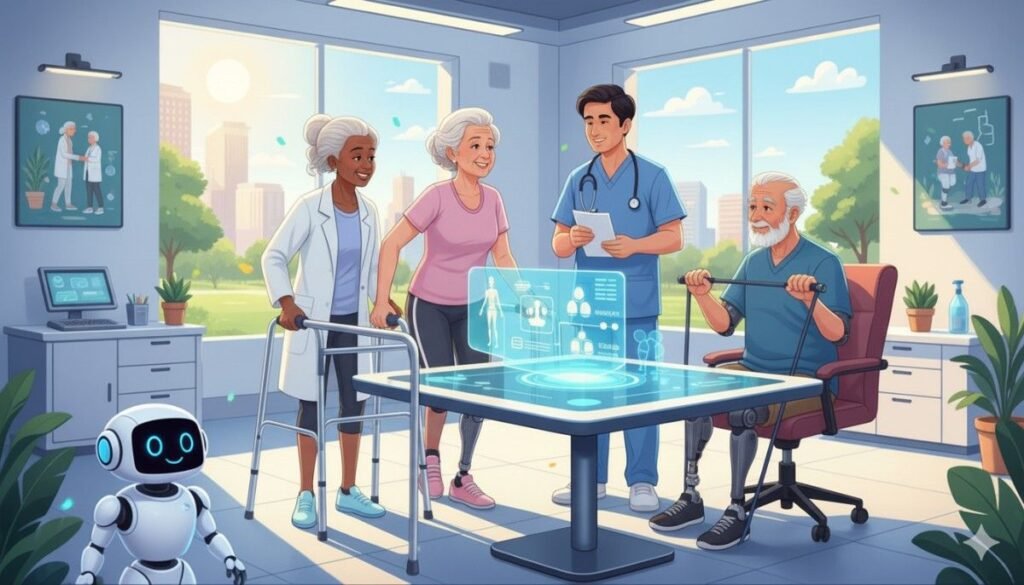
Unlike younger users, older adults need a slower, more gradual introduction to prosthetics. The first sessions should focus on comfort and confidence rather than speed or endurance.
Simple goals — standing upright, balancing for a few seconds, or taking a single step — help the body and mind adjust. Each success reinforces self-belief and prepares the patient for the next challenge.
Physicians should remind families that patience pays off. Rushing progress often leads to fatigue, frustration, or rejection of the prosthesis.
Collaboration Between Doctor and Prosthetist
The collaboration between physician and prosthetist determines the success of geriatric rehabilitation. A well-fitted prosthesis prevents pressure sores, discomfort, and poor posture.
Physicians must ensure that the prosthetist has complete medical information — including circulation health, bone density, and skin condition — before designing the limb.
Once fitted, regular checkups with both doctor and prosthetist help identify issues early and maintain comfort over time.
Encouraging Daily Activity
For elderly patients, consistency matters more than intensity. Even light daily movement keeps joints flexible and muscles engaged.
Doctors can suggest simple routines like short hallway walks, seated leg lifts, or stretching while watching television. These small habits maintain momentum and prevent stiffness.
When movement becomes a normal part of life, prosthetic adaptation feels natural rather than forced.
Pain Management and Comfort
Some elderly amputees avoid prosthetic use because of discomfort or residual limb pain. Physicians should address these issues promptly.
Good pain management — through medication, massage, or heat therapy — can make a huge difference. Ensuring that the prosthetic socket fits correctly also prevents irritation.
Comfort builds confidence. When patients feel at ease, they’re more willing to practice and progress.
Family and Social Support
Recovery isn’t only medical — it’s social. Family members provide the daily encouragement that keeps elderly patients going.
Physicians should involve them in training, teaching them how to assist without taking over. Small gestures like walking beside the patient, cheering progress, or sharing responsibilities create emotional safety.
When seniors feel supported, they’re less afraid to try again after setbacks.
Celebrating Small Victories
Every achievement — standing for longer, walking unaided, or managing daily chores — deserves recognition.
Physicians can reinforce progress with words of encouragement, and families can mark milestones with small celebrations. These gestures keep motivation alive and make rehabilitation a journey worth remembering.
A positive emotional environment is one of the strongest predictors of long-term success.
Modern Prosthetic Innovations for the Elderly
Lightweight Design for Comfort
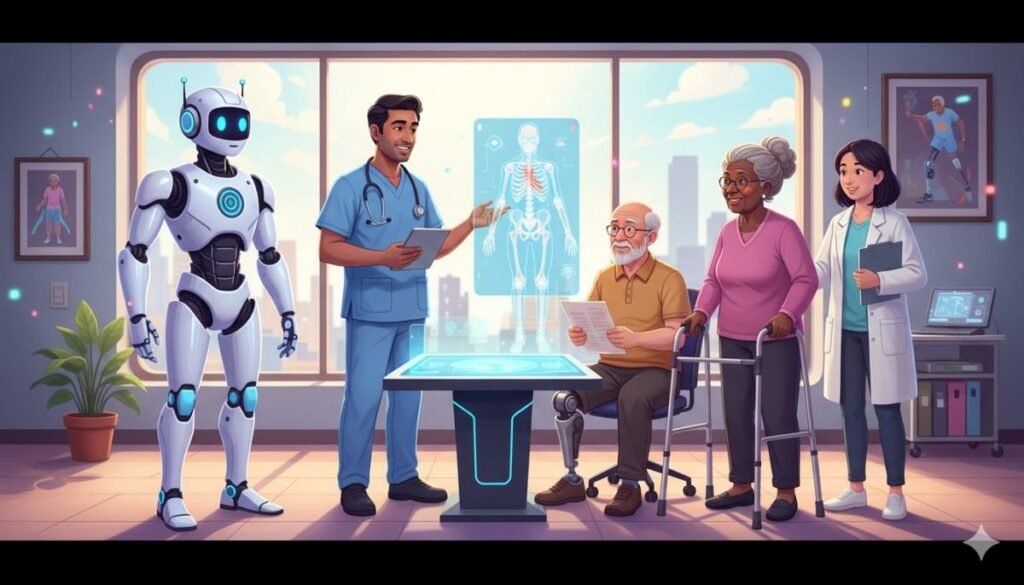
For older adults, comfort is everything. Heavy prosthetics can cause fatigue and imbalance, leading to early abandonment.
Modern devices are designed using lightweight materials like carbon fiber and high-grade polymers that mimic natural movement without strain. They reduce energy consumption and improve endurance, even for frail users.
Physicians should guide patients toward these options to make mobility less tiring and more sustainable.
Enhanced Stability Features
Elderly users benefit from prosthetic designs that enhance stability and grip. Advanced footplates, shock absorption, and microprocessor-controlled joints help maintain steady balance on uneven surfaces.
For upper-limb amputees, ergonomic hand designs prevent shoulder strain and allow smoother motion.
RoboBionics’ prosthetic systems, for example, prioritize ease of use, intuitive control, and stability — features especially vital for geriatric users adapting at a slower pace.
Myoelectric Control and Ease of Use
Myoelectric technology, which detects natural muscle signals, allows hands and arms to move intuitively. This makes prosthetic control easier and more natural, reducing learning time for older adults.
With these devices, daily activities — holding utensils, writing, or dressing — become simpler. The focus is not on complexity but on restoring independence through comfort.
Local Innovation and Accessibility in India
India’s prosthetic landscape is rapidly evolving. Affordable, high-quality solutions like those offered by RoboBionics are bringing advanced technology to the local population.
By manufacturing most components domestically, these innovations are not only cost-effective but also easier to service and customize.
For physicians, this means they can confidently recommend advanced prosthetics without worrying about financial strain for patients.
Ethical and Emotional Dimensions of Geriatric Prosthetic Care
The Doctor’s Role Beyond Medicine
When caring for elderly amputees, physicians become more than just clinicians — they become guides through uncertainty. Older patients don’t just need prescriptions; they need reassurance that life can still be fulfilling.
Each consultation is a chance to restore dignity. Every word of encouragement helps rebuild confidence. Doctors who see beyond the wound and focus on the whole person can transform how aging patients experience recovery.
The elderly often measure hope by the tone of their doctor’s voice. A calm, patient conversation can mean more to them than any medical chart ever could.
Understanding Emotional Readiness
Elderly patients vary widely in how they handle loss. Some accept their amputation with quiet strength, while others struggle to adapt. Recognizing this emotional readiness is critical before introducing prosthetics.
Physicians should look for signs of curiosity, motivation, and willingness to participate in rehabilitation. When patients feel emotionally safe, they’re more likely to embrace the process and stay committed.
Empathy becomes the bridge between medical treatment and mental acceptance. Without it, even the best prosthesis will stay unused.
The Family’s Emotional Journey
Families also experience fear and uncertainty. They may worry about the elder’s pain, ability to adapt, or costs involved. Doctors must address these concerns honestly while emphasizing the potential for regained independence.
Inviting family members into discussions builds trust and understanding. When they see the possibilities clearly, they become active partners in recovery instead of passive observers.
A family that believes in progress creates an environment where healing feels natural and constant.
Managing Expectations with Compassion
Older adults may compare themselves to younger amputees who adapt faster. It’s important for doctors to set gentle, realistic expectations.
Explain that rehabilitation may take longer, but every effort will improve quality of life. Even the ability to walk safely across a room or hold objects comfortably can make a huge emotional difference.
Reassure them that it’s not about regaining what was lost — it’s about discovering new ways to live fully.
Ethical Timing and Consent
In geriatric prosthetic care, timing must respect both physical readiness and emotional consent. A patient who feels pressured may withdraw completely.
Physicians should ensure the patient understands each step — from fitting to training — and agrees to proceed. Clear, simple explanations prevent anxiety and build a sense of control.
Ethics in this context means empowerment. The elderly must feel they are choosing recovery, not being forced into it.
Communication: The Heart of Successful Care
Speaking in Simple, Honest Language

Older patients often struggle to grasp technical explanations. Using plain, compassionate language ensures understanding and comfort.
Instead of saying “You’ll need rehabilitation for functional mobility,” say “We’ll help you move safely again.” Instead of “Your prosthesis will compensate for your limb loss,” say “Your new limb will help you walk or hold things more easily.”
This approach turns confusion into confidence. It also builds stronger doctor-patient relationships based on trust rather than fear.
Listening with Patience
Elderly patients may repeat questions or express doubts frequently. Listening patiently shows respect.
Allowing time for them to process information and respond at their pace prevents overwhelm. It also strengthens their willingness to cooperate during rehabilitation.
Doctors who listen more than they speak often get the best results — because patients feel truly heard.
Reinforcing Hope Through Small Wins
Every check-up is an opportunity to highlight progress. Acknowledge improvements, however small.
Comments like “You’re standing taller today” or “Your balance has improved a lot” reinforce motivation. These positive reinforcements help patients internalize success and keep striving for more.
Hope grows in increments — not through grand gestures, but through consistent encouragement.
Building Communication Between Specialists
Geriatric prosthetic care involves multiple professionals — physicians, prosthetists, therapists, and nurses. Miscommunication between them can cause delays or confusion.
Doctors should encourage open, coordinated updates among all team members. This ensures smooth transitions from hospital care to prosthetic fitting and home rehabilitation.
When communication flows well, patients feel guided, not passed between departments.
Long-Term Maintenance and Follow-Up Care
The Need for Continuous Monitoring
Older bodies change faster than younger ones. Weight fluctuations, muscle loss, or swelling can alter prosthetic fit within months.
Regular check-ups every 3 to 6 months ensure the prosthesis continues to fit comfortably and function safely. Physicians should educate patients and caregivers to report early signs of discomfort, redness, or imbalance.
Preventing small issues from becoming major complications is the cornerstone of geriatric care.
Maintaining Strength and Flexibility
Physical activity shouldn’t end once the prosthesis fits well. Gentle daily movement maintains muscle tone and circulation.
Encourage patients to perform simple stretches, light resistance exercises, or short walks if safe. Even basic household activities — watering plants, cooking, or folding laundry — help preserve strength.
When seniors stay active, the prosthetic becomes an extension of life, not a burden.
Managing Skin and Comfort
The skin of elderly users is thin and sensitive. Physicians must stress daily hygiene and inspection of the residual limb.
A clean, dry limb prevents infections and irritation. Moisturizing lightly can help avoid cracks or dryness. If redness persists, a prosthetist should review the socket for pressure points.
Comfort is the first rule of long-term success. Without it, confidence fades quickly.
Addressing Fear of Falling Again
Even after months of safe walking, some patients retain a quiet fear of falling. Periodic balance training or short refresh sessions with therapists can reinforce trust in their movement.
Encouraging group therapy sessions with other elderly prosthetic users can also help. Shared experience replaces fear with reassurance.
A supportive community is one of the best fall prevention tools available.
Upgrading or Adjusting Prosthetics
As seniors grow older, their needs evolve. Some may need lighter limbs, improved sockets, or adaptive technology for better comfort.
Doctors should discuss these options openly, ensuring that upgrades happen before the current device becomes uncomfortable.
Modern innovations now allow elderly patients to experience improved balance, touch feedback, and smoother movement — all at affordable costs, thanks to Indian innovation.
Redefining Aging With Prosthetics
Moving From Survival to Living
For decades, prosthetic care in elderly patients was focused solely on function — standing, walking, eating. But the conversation is changing.
Now, the focus is on living well — participating in family gatherings, gardening, visiting friends, or simply moving around independently. These are not luxuries; they are lifelines to emotional health.
Prosthetics today allow elderly individuals to do more than survive — they allow them to live with freedom, grace, and pride.
Technology Designed for Dignity
Modern prosthetics have evolved far beyond rigid mechanical designs. Lightweight, responsive devices now make movement feel natural. Myoelectric systems, such as those developed by RoboBionics, use the body’s own muscle signals for control.
This means elderly users don’t have to struggle with switches or complex systems. The prosthesis responds intuitively, giving them back control over their day-to-day life.
RoboBionics’ Sense of Touch™ technology goes one step further by offering sensory feedback — allowing users to “feel” pressure when holding objects. For seniors, this small ability can mean the difference between hesitation and confidence.
Affordability and Access in India
In India, the biggest challenge for geriatric care has always been accessibility. Imported prosthetics are costly and often unavailable in smaller towns.
RoboBionics changes this equation. By manufacturing 60 of 64 components locally, it keeps costs between ₹2.15–3 lakh, making world-class prosthetics accessible to thousands.
This affordability means physicians can confidently recommend advanced devices without worrying about financial strain on families.
The goal is simple — no elderly Indian should be denied mobility due to cost.
The Physician as an Advocate
Doctors play a powerful role in shaping how society views prosthetic rehabilitation in older adults. By recommending early intervention and advanced local options, they help remove stigma and promote independence.
Every conversation a physician has with a patient or family is an opportunity to redefine aging — not as decline, but as adaptation and resilience.
The message should always be one of strength: “You can still live fully, and we’ll help you do it.”
The Joy of Rediscovered Freedom
There’s nothing more inspiring than seeing an elderly patient take confident steps again. Many describe it as “getting life back.”
When they realize they can walk to the garden, hold a grandchild, or cook again without fear, it rekindles purpose. That joy spreads through families, changing the emotional climate at home.
This transformation is what makes prosthetic care more than a medical service — it becomes a celebration of human spirit.
The Future of Geriatric Prosthetic Care in India
Building Integrated Care Systems
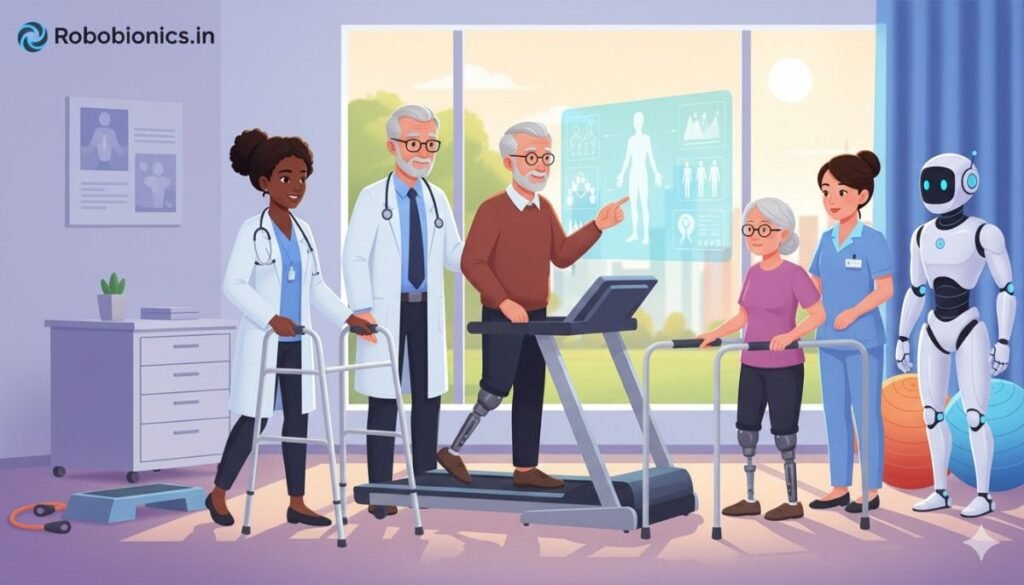
As India’s population ages, the demand for geriatric prosthetic care will only grow. The future lies in integration — hospitals, prosthetic centers, and rehabilitation experts working together from the start.
Early referrals, shared follow-ups, and coordinated patient education will ensure faster recovery and higher satisfaction.
When prosthetic care becomes part of standard geriatric medicine, patients receive not just treatment, but lifelong support.
Training Physicians for the New Era
Many doctors were trained in an era when prosthetics were basic and limited. Continuous education programs can update them on new technologies, early fitting protocols, and psychological care methods.
Workshops and partnerships with prosthetic manufacturers like RoboBionics can equip physicians with hands-on knowledge of the latest systems.
When doctors are informed, patients are empowered.
Expanding Outreach and Awareness
Rural awareness remains a major gap. Many elderly amputees in smaller towns never learn that prosthetics can restore their independence affordably.
Collaborations between hospitals, NGOs, and companies like RoboBionics can bring mobile prosthetic clinics and awareness drives to underserved areas.
Bridging this gap ensures that innovation benefits everyone — not just those in major cities.
The Role of Compassionate Technology
Technology is most powerful when it feels human. As prosthetics become more advanced, the focus must remain on empathy — designing for comfort, dignity, and simplicity.
Elderly users don’t need complexity. They need ease, trust, and reliability. Devices built with these values truly honor the human experience.
A Vision for Tomorrow
Imagine an India where no elderly person feels limited by frailty or fear. Where losing a limb doesn’t mean losing independence. Where physicians treat prosthetic rehabilitation as a continuation of care, not an afterthought.
That vision is within reach — through compassion, collaboration, and innovation.
Conclusion: Redefining Strength in the Golden Years
Aging with grace is about more than survival. It’s about moving, feeling, and living with dignity. For elderly amputees, the right prosthetic care brings back that grace.
When physicians act early, fit wisely, and communicate with empathy, they give their patients something priceless — freedom.
Modern prosthetics, like those from RoboBionics, are not just tools. They’re bridges between limitation and possibility. They turn fear into courage and frailty into confidence.
For every elderly person who walks again, holds a cup, or simply smiles knowing they can still do things on their own — that’s progress. That’s purpose. That’s life, restored.
If you’re a physician, caregiver, or family member seeking guidance on early prosthetic fitting and elderly mobility, connect with RoboBionics today.
Book a demo or consultation at www.robobionics.in/bookdemo — and together, let’s help India’s seniors stand strong, steady, and proud again.



